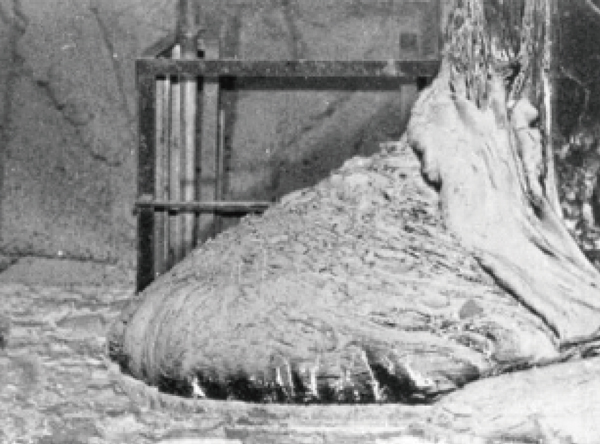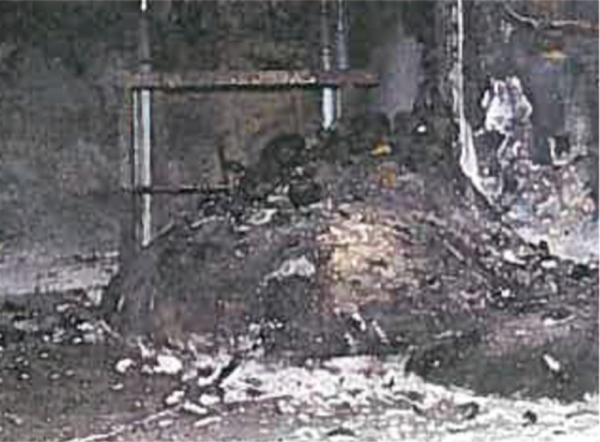
Fig.1 “Elephant foot” observed immediately after the accident*1

Fig.2 “Elephant foot” about 10 years after the accident*2
The fuel debris generated in the reactors during the accident at TEPCO's Fukushima Daiichi Nuclear Power Station (FDNPS) in 2011 may undergo changes in its physical and chemical properties because of aging over the removal period of several decades. These changes may affect the retrieval process. Hence, it is important to predict the aging of fuel debris, but such knowledge is limited to that gained from the Chornobyl Nuclear Power Plant Unit 4 (ChNPP-4), where an accident occurred in 1986. In ChNPP-4, for example, it has been confirmed that fuel debris shaped like an “elephant’s foot” as shown in Fig.1 has been significantly aging over time, as shown in Fig.2, about 10 years after the accident. Therefore, in this study, we investigated the knowledge on the aging of fuel debris formed in the ChNPP-4 accident and discussed the aging of fuel debris in the FDNPS and its effects.
The aging of materials is generally classified into three based on their mechanisms: physical, chemical, and biological aging. Physical aging refers to material degradation without any chemical change. Chemical aging is caused by a chemical reaction without biological effects. Biological aging is due to biological interactions such as interactions with microorganisms.
The physical aging of fuel debris in ChNPP-4 is attributed to seasonal and daily temperature changes, airflow caused by pressure differences inside the building, and due to self-irradiation of radiation due to α-decay, but these effects are considered to be relatively small. Next, chemical aging is mainly attributed to reaction with water that has become more reactive due to radiation, and precipitates containing uranium as the main component have been confirmed. These precipitates are regarded to have actually been formed by reaction with moisture. In addition, many microorganisms such as fungi have been confirmed in the building, and the effects of biological aging due to microorganisms have been discussed, but the detailed mechanism is not well understood.
Based on these findings, we considered the effects of the aging of fuel debris on the FDNPS as follows. The current FDNPS in-vessel is maintained in an inert atmosphere, and it is in a very stable condition in which cooling water is continuously injected with hydrazine, which inhibits oxidation and prevents the growth of microorganisms. Therefore, the aging of fuel debris is expected to be smaller than that in the case of ChNPP-4. Formation of the rust layer on the surface of fuel debris mainly composed of iron immersed in water is expected to increase drastically temporarily, but the rust layer possibly delays the corrosion in the long term. In addition, the dissolution of uranium-rich fuel debris is also likely to be limited.
In the future, when the removal of fuel debris begins, oxygen will be mixed in and the flow of accumulated water will fluctuate. These changes may promote the chemical aging of fuel debris, change its chemical properties, and affect solubility and radionuclide dispersion behavior. Therefore, to minimize the effects of aging during the removal process, it is important to maintain the inert atmosphere inside the vessel and suppress fluctuations in water flow. In addition, we believe that it is important to conduct research that considers the effects of oxygen in the event that oxygen contamination is unavoidable.
This work was supported by JSPS KAKENHI Grant-in-Aid for Early-Career Scientists (JP21K14568).
(Toru Kitagaki)
*1 Arutyunyan, R.V. et al., Nuclear Fuel in the “Shelter” Encasement of the Chernobyl NPP, 2010, 240p. (in Russian).
*2 Ishikawa, H., Fifteen Years After the Accident at the Chernobyl Nuclear Power Plant -Lessons Learned-, Journal of the Atomic Energy Society of Japan, vol.44, no.2, 2002, p.179-186 (in Japanese).
<Previous: 8 Research and Development Related to the Accident at TEPCO’s Fukushima Daiichi NPS | Next: 8-2>